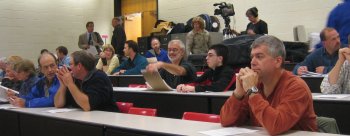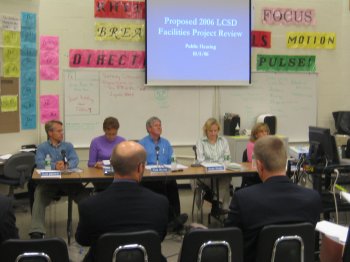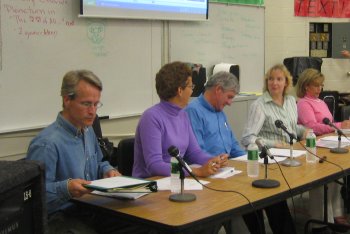- By Dan Veaner
- News
 Print
Print
Public reaction was generally positive at a Lansing school capital project public information meeting a week ago. The Board Of Education (BOE) held the meeting to explain a proposal submitted by the Facilities group of district residents, teachers and administrators. The group met from March through last month to develop a project that school officials hope will be acceptable to taxpayers. The 19.8 million dollar project, half the cost of an earlier proposal that died because it was not supported, will cost taxpayers about $1.12 per assessed $1000 the first year, and an average of 94 cents per thousand in an average year.

School officials presented the project to the public, explaining the scope, cost, and tax impact. Much of the project is focussed on repairs and infrastructure in the three school buildings. Construction to address current program needs in the High School are also included. Principal Michelle Stone explained those needs in detail and demonstrated how the project could alleviate program and over crowding in the school. She explained that 100% of the rooms in her school are booked well above the recommended 80%, and that many teachers spend time travelling to make room for other teachers in their classrooms.
While the Facilities Group had chosen not to include a solution to the deteriorating district office, BOE member Dan Brown suggested that a capital solution be added to the proposed project. He said it would cost taxpayers less in the long run than leasing options that are being considered, as well as meeting the district goal of keeping the office on the school campus. He suggested adding it as a separate proposal when the project comes up for a vote, saying that if taxpayers want to spend more on a lease or lease to purchase arrangement they could vote the proposal down.
The facilities committee recommended that $2.1 million of the project that would include music and technology rooms be split from the main proposal into a separate proposition for taxpayers to vote on. A number of parents spoke in favor of the music and theater program, including Doug Emerick, saying it motivates kids to go to school. "If the kids enjoy it and makes them want to come to school, then it's worth every penny," he said. "These kids aren't hanging out on the streets, hanging out on the corners."

School Board members (left to right) Dan Brown, Sandy Dhimitri,
Tom Keane, Anne Drake, Bonita Lindberg
Dan Konowalow said that the BOE has to consider lengthening the school day, rather than expanding the High School. But Stone explained, not for the first time, the problems inherent in that, which include conflicting with off-campus programs such as BOCES programs, extra curricular activities, and staffing issues that would require extra expenses to the district for teachers and support staff.
A high school student reinforced that view to much applause, saying, "I participate in extra curricular activities, and that's as much of the experience as school is. Adding extra time will push those out. Besides that you have your homework to think about." She said that the over crowding in the high school is much more noticeable this year, with 40 more students in the building than last year.
Dawn Urbany, the Middle School Spanish teacher, read a statement from the 7th grade team to make sure the BOE knows that the heat in their second floor rooms is often unbearable, going as high as a hundred degrees with 90% to 100% humidity in June. Middle school program issues had been taken off the table to give the district time to consider redistribution of the grades among the middle and elementary schools. But the letter asked the board to address this problem in the current project.
In response to concerns that the school population will go down after the additional space is built, Maureen Bell challenged the projections the district has used. Noting that she is a scientist who has worked for NASA for 30 years working with models, she said, "The models that are used for the projection of our enrollment are based on the birth rate in Tompkins County," she said. "As we who live here know is that's not what increases our enrollment. What increases our enrollment was, in this case, Lakewatch being built, Autumn Ridge being built, Lakeview being built all at the same time. The projection models do not take that into account." She also noted that the models used are not consistent from year to year.

Most speakers were supportive, and many had questions about how the project would affect their kids. Architech Kirk Narburgh explained that most construction that could be disruptive takes place in the summer, saying that is why the proposed construction season includes two summers. Some parents said the proposal doesn't do enough. "What we've got here is what I call the minimum to keep us where we're at," said Mike Coles. "But it's not going to get you any further ahead."
At an abbreviated BOE meeting last night the board voted to accept the capital project portfolio as developed by the Facilities Committee, and to place it before the voters on or about February 6th. Board members began a discussion of what the project should contain in its final form. Notably they are revisiting building or rennovating a district office, which could potentially add up to an additional $1.19 million to the project.
Brown said that a solution to the deteriorating district office should be included in the main proposition. "It's something that we have to do to provide an appropriate work environment for the people in the district office," he said. The BOE was invited to tour the Advanced Design building on October 26th. The building is for sale, and the district is considering buying or leasing it. Other options include building a district office in existing classroom space, rennovating the current building, or placing a pre-manufactured building on the site of the old restaurant near the middle School. The board will decide on a solution at their October 26th meeting.
----
v2i39

School officials presented the project to the public, explaining the scope, cost, and tax impact. Much of the project is focussed on repairs and infrastructure in the three school buildings. Construction to address current program needs in the High School are also included. Principal Michelle Stone explained those needs in detail and demonstrated how the project could alleviate program and over crowding in the school. She explained that 100% of the rooms in her school are booked well above the recommended 80%, and that many teachers spend time travelling to make room for other teachers in their classrooms.
While the Facilities Group had chosen not to include a solution to the deteriorating district office, BOE member Dan Brown suggested that a capital solution be added to the proposed project. He said it would cost taxpayers less in the long run than leasing options that are being considered, as well as meeting the district goal of keeping the office on the school campus. He suggested adding it as a separate proposal when the project comes up for a vote, saying that if taxpayers want to spend more on a lease or lease to purchase arrangement they could vote the proposal down.
The facilities committee recommended that $2.1 million of the project that would include music and technology rooms be split from the main proposal into a separate proposition for taxpayers to vote on. A number of parents spoke in favor of the music and theater program, including Doug Emerick, saying it motivates kids to go to school. "If the kids enjoy it and makes them want to come to school, then it's worth every penny," he said. "These kids aren't hanging out on the streets, hanging out on the corners."

School Board members (left to right) Dan Brown, Sandy Dhimitri,
Tom Keane, Anne Drake, Bonita Lindberg
Dan Konowalow said that the BOE has to consider lengthening the school day, rather than expanding the High School. But Stone explained, not for the first time, the problems inherent in that, which include conflicting with off-campus programs such as BOCES programs, extra curricular activities, and staffing issues that would require extra expenses to the district for teachers and support staff.
A high school student reinforced that view to much applause, saying, "I participate in extra curricular activities, and that's as much of the experience as school is. Adding extra time will push those out. Besides that you have your homework to think about." She said that the over crowding in the high school is much more noticeable this year, with 40 more students in the building than last year.
Dawn Urbany, the Middle School Spanish teacher, read a statement from the 7th grade team to make sure the BOE knows that the heat in their second floor rooms is often unbearable, going as high as a hundred degrees with 90% to 100% humidity in June. Middle school program issues had been taken off the table to give the district time to consider redistribution of the grades among the middle and elementary schools. But the letter asked the board to address this problem in the current project.
In response to concerns that the school population will go down after the additional space is built, Maureen Bell challenged the projections the district has used. Noting that she is a scientist who has worked for NASA for 30 years working with models, she said, "The models that are used for the projection of our enrollment are based on the birth rate in Tompkins County," she said. "As we who live here know is that's not what increases our enrollment. What increases our enrollment was, in this case, Lakewatch being built, Autumn Ridge being built, Lakeview being built all at the same time. The projection models do not take that into account." She also noted that the models used are not consistent from year to year.

Most speakers were supportive, and many had questions about how the project would affect their kids. Architech Kirk Narburgh explained that most construction that could be disruptive takes place in the summer, saying that is why the proposed construction season includes two summers. Some parents said the proposal doesn't do enough. "What we've got here is what I call the minimum to keep us where we're at," said Mike Coles. "But it's not going to get you any further ahead."
At an abbreviated BOE meeting last night the board voted to accept the capital project portfolio as developed by the Facilities Committee, and to place it before the voters on or about February 6th. Board members began a discussion of what the project should contain in its final form. Notably they are revisiting building or rennovating a district office, which could potentially add up to an additional $1.19 million to the project.
Brown said that a solution to the deteriorating district office should be included in the main proposition. "It's something that we have to do to provide an appropriate work environment for the people in the district office," he said. The BOE was invited to tour the Advanced Design building on October 26th. The building is for sale, and the district is considering buying or leasing it. Other options include building a district office in existing classroom space, rennovating the current building, or placing a pre-manufactured building on the site of the old restaurant near the middle School. The board will decide on a solution at their October 26th meeting.
----
v2i39



